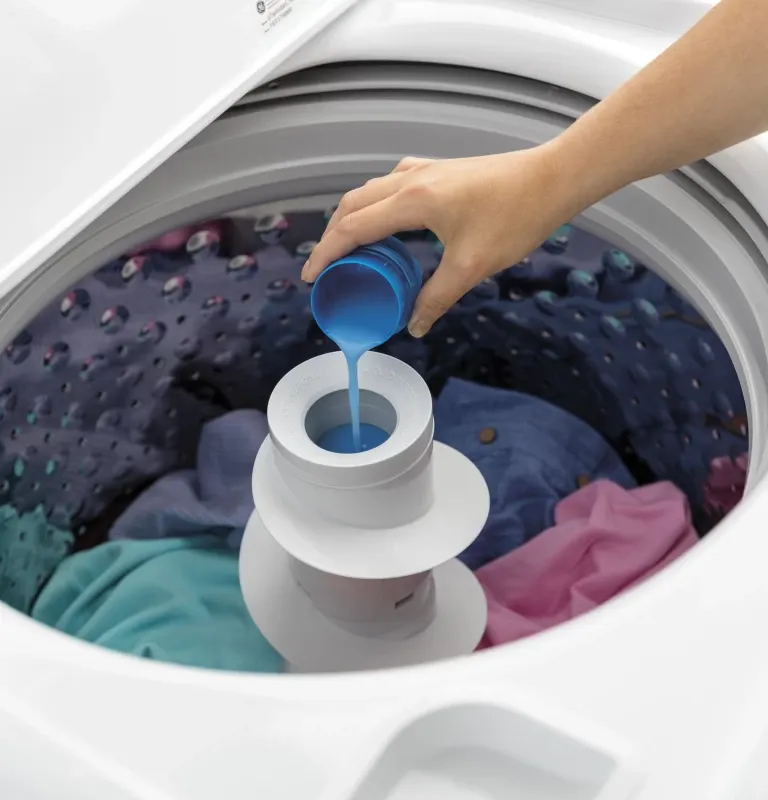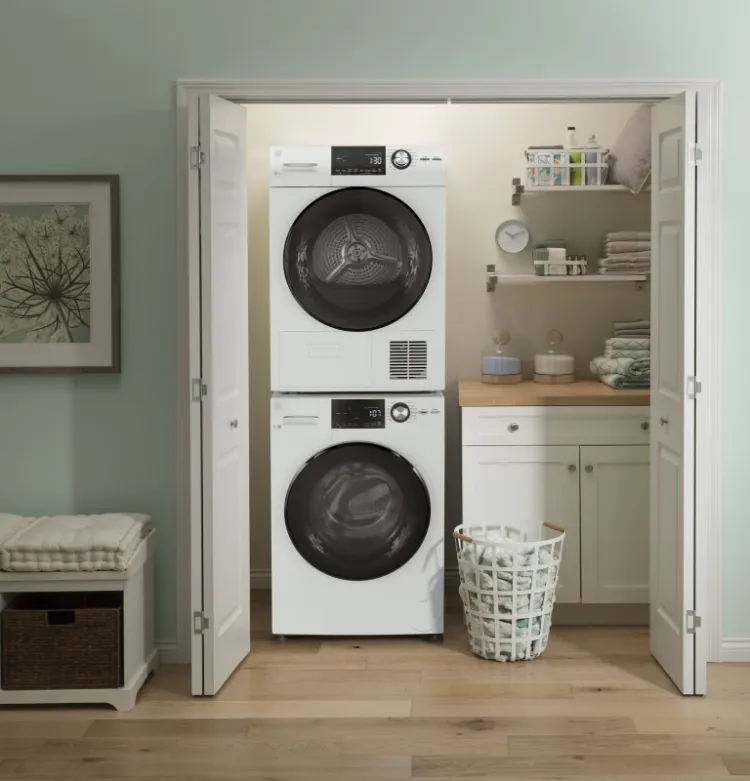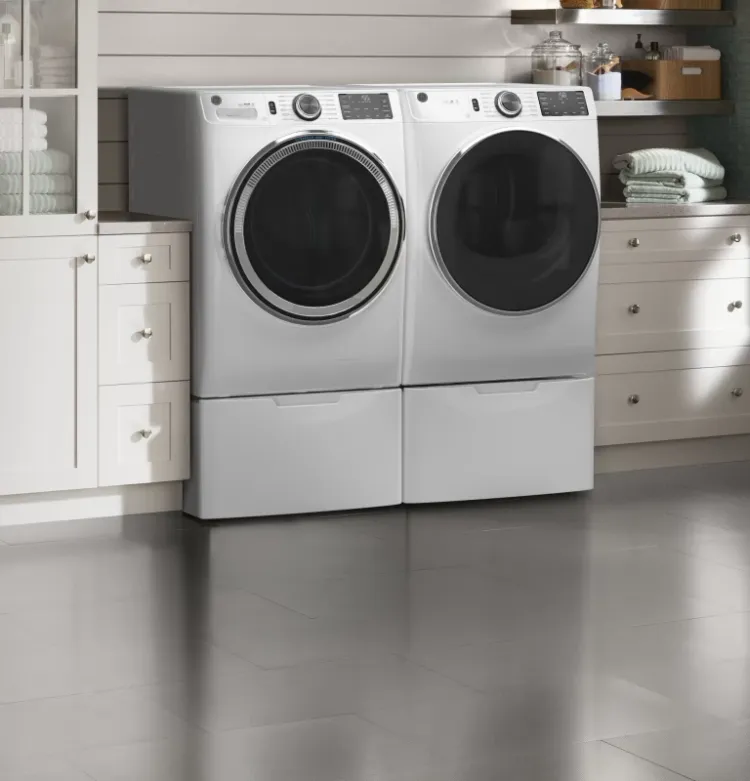The Key to Perfect Laundry: Knowing Where to Put Detergent in Your Washer

Doing laundry may seem straightforward, but achieving pristine, fresh-smelling clothes involves more than just tossing your clothes into a washer. One crucial step that may not seem that important, is the correct placement of your laundry detergent. This can significantly impact your laundry routine, ensuring your clothes come out clean and well cared for every time.
By focusing on the proper ways to add detergent, whether you're using traditional powders, liquid detergents, laundry pods, or HE (High Efficiency) detergents, you'll be equipped with the knowledge needed for effective cleaning.
This informative guide is here to help you achieve the perfect load of laundry with every wash. So let's unravel the mystery of where to put detergent in a washer, paving the way for cleaner, fresher clothes, and a more efficient laundry routine.
Understanding Your Washing Machine: Front-Loading vs. Top-Loading Washers
When it comes to doing laundry, not all washing machines are created equal. The type of washer you have—be it front-loading or top-loading—plays a pivotal role in how you go about adding laundry detergent for an effective wash. This section aims to differentiate between these two popular types of washing machines, ensuring you understand the nuances of each and the importance of using the correct detergent type to maximize cleaning efficiency and most importantly, protect your appliance from damage.
Front-Loading Washers
Front-loading washers have gained popularity for their efficiency and gentleness when they clothes. These machines require a specific approach to detergent placement due to their design and washing mechanics. Typically, front loaders feature a detergent drawer or dispenser drawer, clearly marked compartments where you add detergent, fabric softener, and, in some cases, bleach to the washing machine. It's crucial to use HE detergents with front-loading washers. HE detergents are specially formulated to produce fewer suds, making them ideal for the low water levels used in these machines. Using regular detergent in a front loader can lead to excessive suds, potentially damaging the machine and affecting the wash quality.
Top-Loading Washers
On the other hand, top-loading washers are the traditional models many grew up with. These machines often allow for more flexibility in detergent placement. You can pour the detergent directly into the drum before adding your laundry or use the dispenser drawer if your model is equipped with one. Top-loaders are generally more forgiving when it comes to the type of detergent used. However, choosing a laundry detergent that matches the machine's efficiency and the water hardness in your area can significantly enhance wash results. While HE detergents work well in high-efficiency top-loaders, traditional detergents are also suitable for models not labeled as high efficiency.
The Significance of Different Laundry Detergent Types
Understanding the difference between front-loading and top-loading washers highlights the importance of selecting the appropriate detergent. The right detergent type not only ensures effective cleaning but also plays a critical role in keeping your washing machine maintained and healthy. Using the wrong detergent can lead to buildup in the machine, affecting performance and potentially leading to costly repairs down the road. Additionally, factors like load size and water hardness should influence your choice of detergent and its placement, whether you opt for liquid detergents, powder, or laundry pods.
Knowing whether you have a front-loading or top-loading washer and putting the right detergent type for each is fundamental to having the perfect wash. This knowledge ensures that every load of laundry you wash not only comes out clean but also contributes to the longevity and efficiency of your washing machine.
Where to Put Laundry Detergent in a Front-Loading Washer: A Complete Guide
Front-loading washing machines, with their sleek design and superior efficiency, have become a staple in modern laundry rooms. Understanding where to put detergent in these models is key to leveraging their cleaning power and ensuring your clothes emerge spotless and fresh. Use this section as a detailed guide on locating and using the detergent drawer in a front-loading washer, and learn some practical tips for using liquid detergent, fabric softeners, and bleach effectively.
Locating and Using the Laundry Detergent Drawer
The detergent drawer, typically located on the front panel of your washer, is an essential feature of front-loading machines. This drawer is designed with separate compartments for each of your different laundry additives:
1. Main Detergent Compartment: This is where you add your liquid or powder laundry detergent. It's crucial to measure the detergent according to the manufacturer's guidelines and the load size. Overloading detergent can lead to residue on your clothes and also in the machine. While underloading might result in less effective cleaning.
2. Fabric Softener Compartment: If you're someone who enjoys using a fabric softener, this compartment is specifically designed for it. The washer will automatically dispense the softener at the optimal time during the rinse cycle, ensuring your clothes come out soft and fragrant.
3. Bleach Compartment: For those occasions when bleach is necessary, using the designated compartment ensures it's used safely and effectively. The machine will dispense the bleach at a point in the cycle where it can do its job without damaging your fabrics.
Tips for Using Liquid Detergent, Fabric Softeners, and Bleach
To make the most of your front-loading washer, consider these tips when using detergents and other laundry additives:
- Liquid Detergent: Ideal for most washing needs, liquid detergent should be poured into the main compartment up to the marked line. Be mindful of the recommended amount to avoid suds buildup and ensure thorough rinsing.
- Fabric Softeners: These should be added to the designated compartment, again, up to the marked line. Avoid overuse, as too much fabric softener can leave clothes feeling greasy and also reduce the absorbency of towels and linens.
- Bleach: When using bleach, ensure it's a suitable choice for the fabric type and color. Fill the bleach compartment to the indicated level, and never mix bleach with other laundry additives in the drawer to prevent chemical reactions.
Understanding where and how to add detergent and other laundry products in your front-loading washer is honestly a crucial practice to ensure an effective cleaning and the utmost care of your machine. Always refer to your washer's manual for specific instructions and recommendations. By following these guidelines, you can maximize the performance of your front-loading washer, extend its lifespan, and keep your clothes looking their best.
Where to Put Detergent in a Top-Loading Washer: The Steps for the Cleanest Clothes
Top-loading washers, the traditional mainstay of many households, offer a straightforward approach to laundry that many find reassuring and easy to manage. However, the simplicity of these machines doesn't eliminate the need for proper detergent use and placement. This section we'll guide you through the process of adding detergent to your top-loading washer, and teach you a few things about detergent use for cleaner, brighter clothes.
Adding Detergent Directly to the Drum
One of the key features of top-loading washers is the ability to add detergent directly to the middle drum before placing your clothes. This ensures that the detergent is evenly distributed throughout the load once the water fills the drum. Here’s how you can do it effectively:
1. Start by measuring the appropriate amount of detergent for your load size and the level of soil in your clothes. Just like as we mentioned above, using too much can leave residue on your clothes and in the machine, while too little may result in less-than-ideal cleaning.
2. Pour the detergent into the empty drum before adding your laundry. This method is especially effective for ensuring that the detergent is well-dissolved and distributed, particularly when using powdered detergents.
3. Add your laundry, making sure not to overload the machine, as this can affect cleaning quality for your clothes and the distribution of detergent.
This straightforward approach to adding detergent helps to make sure that your top-loading washer keeps your clothes as clean as possible and keeps your washer running efficiently.
The Use of Laundry Pods and Where to Put Them
Laundry pods have surged in popularity due to their convenience and pre-measured doses of detergent. They make laundry easy by eliminating the guesswork for load sizes. When using laundry pods in a top-loading washer, it's essential to place them correctly to ensure they dissolve properly and distribute the laundry detergent evenly:
- Place the laundry pod at the bottom of the drum before adding your clothes. This placement ensures that the pod comes into contact with water as soon as the cycle starts, allowing it to properly dissolve.
- Avoid placing laundry pods in the detergent drawer or on top of the laundry, as this can prevent the pods from dissolving fully, leaving residue on your clothes or in the machine.
- Use the recommended number of pods based on your load size and the manufacturer’s instructions. Just like with power and liquid detergent, overuse can lead to soap residue, while underuse might result in insufficient cleaning.
Understanding where to put detergent in your top-loading washer, whether you're using liquid detergent, powder, or laundry pods, really makes all the difference when you want the best laundry results.
Special Considerations for High-Efficiency (HE) Washers: The Role of HE Laundry Detergents
High-Efficiency (HE) washers are a significant advancement in laundry technology, offering numerous benefits over traditional washing machines. This includes things like reduced water usage and energy consumption. To fully leverage these advantages and protect your investment, it's crucial to use HE detergents specifically designed for these machines. This section will go into the importance of HE detergents and why they are essential for avoiding damage to your HE washer while ensuring operational efficiency.
Why HE Detergents Are Essential
HE detergents are made to produce fewer suds than traditional laundry detergents, a critical factor in the functionality of HE washers. These machines use less water than conventional washers, meaning excess suds can significantly hinder their cleaning and rinsing cycles. Here's why using HE detergents is vital for your HE washer:
- Reduced Suds for Better Cleaning: HE detergents are designed to create a minimal amount of suds, ensuring that the low water levels in HE machines can still provide effective cleaning. Excessive suds can trap dirt and bacteria within the foam, preventing them from being thoroughly rinsed away from your clothes.
- Preventing Damage to the Machine: The use of non-HE detergents in HE washers can lead to suds buildup, which may cause mechanical problems and affect the efficiency of your washer. Over time, this buildup can damage the machine's internal components, leading to costly repairs or even the need for a replacement.
- Enhanced Efficiency: HE detergents are concentrated, and require less detergent per load. This concentration not only means that you use less product, making HE detergents more cost-effective in the long run, but also contributes to the overall energy and water efficiency of your washing machine.
Tips for Using HE Detergents
To get the most out of your High-Efficiency washer and detergent, consider the following tips:
- Follow Manufacturer Recommendations: Always use the amount of HE detergent recommended by the washer manufacturer. Even though HE detergents are low-sudsing, using too much can still lead to suds-related issues.
- Choose the Right Detergent for Your Needs: HE detergents come in liquid, powder, and pod forms. Consider your laundry habits and preferences when selecting an HE detergent, ensuring it's suitable for your washer and laundry types.
- Regular Maintenance: To maintain the efficiency of your HE washer, run a cleaning cycle as recommended by the manufacturer, using an HE detergent or a washer cleaner. This routine helps prevent odor and residue buildup, ensuring your machine operates at peak efficiency.
Common Mistakes to Avoid for The Best Laundry Results
To get the most out of your washer, it involves more than selecting the right detergent and settings on the washing machine. It's also crucial to avoid common mistakes that can lead to poor wash results or even damage your machine over time. Let's highlight two frequent errors in laundry care: overusing detergent and neglecting regular cleaning of the washer and your detergent drawer. Understanding these pitfalls can help ensure your clothes are clean, fresh, and well-maintained.
Overusing Detergent and Its Consequences
The belief that more detergent equals cleaner clothes is a common misconception that can actually have several negative consequences, both for your laundry and your washing machine:
- Residue on Clothes: Using too much detergent can leave a residue and film on your clothes, making them feel stiff and even start to look dull. This residue can actually attract more dirt and can be particularly problematic for those with sensitive skin.
- Machine Damage: Excessive detergent suds can strain your washing machine's pump and motor, leading to potential damage and costly repairs over time. In HE washers, the problem is worse due to their low-water usage. Too much detergent can lead to an overflow of suds and residue buildup in the machine's inner workings.
- Wasted Detergent: Besides the potential for damage and poor laundry results, overusing detergent is just simply wasteful. Following the recommended detergent amount can save money and contribute to a more environmentally friendly laundry process.
The Impact of Not Cleaning your Washer and Detergent Drawer Regularly
Just as your clothes need regular cleaning, so does your washing machine. Neglecting this critical maintenance task can have several negative impacts:
- Odors and Mold: Detergent and fabric softener residue, along with the moisture inherent in washing machines, can create an ideal environment for mold and mildew growth. This can lead to unpleasant odors that may transfer to your clothes.
- Reduced Efficiency: Buildup from detergents and fabric softeners can clog the detergent drawer and other parts of the washer, reducing the machine's effectiveness and potentially leading to malfunctions.
- Poor Cleaning Performance: Residue buildup in the drum can redeposit dirt and soap scum onto your clothes, leading to a cycle of poor cleaning performance that defeats the purpose of doing laundry.
Tips for Proper Washer Maintenance
To avoid these common mistakes, follow these practical tips:
- Measure Detergent Carefully: Always use the recommended amount of detergent for your load size and the water hardness in your area. Consider using a measuring cup or the cap of the detergent bottle for precise measurements and cleaner clothes.
- Clean Your Machine Regularly: Most modern washers have a self-clean cycle designed to remove residue and odors. Run this cycle monthly, or as recommended by the manufacturer, to keep your machine fresh and efficient.
- Maintain the Detergent Drawer: Remove and clean the detergent drawer regularly to prevent buildup. Warm, soapy water is usually sufficient to remove residue and ensure smooth operation.
When you avoid these common laundry mistakes and keep up with the proper maintenance routines, you can extend the life of your washing machine, save money, and enjoy better laundry results. Not to mention how you're laundry will be cleaner than ever.
Tips for Effective Detergent Placement: Maximizing Laundry Efficiency
The placement and amount of detergent you use in your washing machine play a significant role in the effectiveness of your laundry routine. By fine-tuning these aspects, you can achieve cleaner clothes, extend the lifespan of your garments, and even save on energy costs. Let's explore some essential tips for effective detergent placement, including the importance of reading the instructions on detergent packages and adjusting detergent amounts based on load size and water hardness. Then you can ensure that every load of laundry comes out fresh and clean.
Reading Instructions on Detergent Packages
One of the simplest yet most overlooked steps in doing laundry is reading the instructions on detergent packages. These guidelines are provided by manufacturers for a reason—they ensure that you use their product effectively, maximizing cleaning power while minimizing waste and potential harm to your washer. Here’s why following the directions on the package is crucial:
- Optimal Dosage: Manufacturers test their detergents extensively to determine the right amount needed for effective cleaning. Following these recommendations can prevent the issues associated with overuse or underuse of laundry detergent.
- Type of Washer: Detergent instructions often vary depending on whether you're using a standard or HE washer. Using the correct type and amount of detergent for your machine type is key to effective cleaning and preventing damage.
- Special Laundry Needs: Some detergents are formulated for specific laundry challenges, such as cold water washing, delicate fabrics, or heavy soil. The instructions can guide you on how to best use the product for these specific needs.
Adjusting Detergent Amount Based on Load Size and Water Hardness
While following the package instructions is a great starting point, you may need to adjust the amount of detergent based on your specific laundry conditions:
- Laundry Load Size: Larger loads of laundry often require more detergent to effectively clean all the garments, while smaller loads need less. Adjust the amount of detergent you use accordingly, that way you can prevent any residue on clothes and ensure each piece is thoroughly cleaned.
- Water Hardness: The mineral content in your water can affect detergent efficiency. Hard water may necessitate more detergent, as minerals can interfere with the cleaning agents. On the other hand, soft water requires less detergent. Knowing your water hardness can help you adjust detergent amounts for optimal cleaning and efficiency.
- Soil Level: Heavily soiled clothes may need a slight increase in detergent to break down and remove those tough stains and odors. However, it's important to balance this with the potential for residue, adjusting only as necessary.
Additional Tips for Specific Washing Machine Brands: Enhancing Your Laundry Experience
Different washing machine brands offer unique features designed to improve your laundry routine, and understanding how to make the most of these brand-specific features can lead to more efficient cleaning and even longer-lasting clothes. Here, we'll cover additional tips for Whirlpool, Samsung, and LG washers, focusing on how to utilize their distinctive capabilities to your advantage.
Whirlpool Washers: Utilizing the Load & Go™ Dispenser for Convenience
Whirlpool has innovated the laundry process with its Load & Go™ dispenser feature, available in select models. This dispenser allows you to fill the detergent reservoir once and then automatically dispenses the right amount of detergent for each load for up to 20 to 40 loads, depending on the model. Here’s how to make the most of it:
- Fill It and Forget It: After filling the Load & Go™ dispenser with your preferred HE liquid detergent, the Whirlpool washing machine will take care of the rest. Each load will receive the correct amount of detergent based on the cycle and load size selected.
- Select the Right Detergent: Use only HE liquid detergents in the Load & Go™ dispenser to avoid any clogging or malfunctions. Sadly this feature is not designed for powder detergents or laundry pods.
- Regular Cleaning: To maintain the best performance for your washer, regularly clean the Load & Go™ dispenser according to the manufacturer’s instructions. That way, you can prevent detergent buildup and ensure the system stays working efficiently.
Samsung: Adjusting Detergent Amount to the Load Size
Samsung washers are known for their advanced technology and user-friendly features. Many models happen to include auto-dispense systems or recommendations for detergent amounts based on the load size. Here’s how to optimize detergent use in your Samsung washer:
- Auto-Dispense Feature: If your model includes this feature, fill the detergent compartment, and the washer will automatically dispense the right amount of detergent. Just make sure that you select the correct detergent concentration settings according to what you're using.
- Manual Adjustment: For models without auto-dispense, adjust the detergent amount based on Samsung’s load size recommendations. Start with the manufacturer's guidelines, and then you can fine-tune the amount based on your specific laundry needs.
LG: Using the Dispenser Drawer Effectively
LG washers often feature a highly organized dispenser drawer that separates detergent, fabric softener, and bleach, ensuring they are added to the wash at the best time. To use the LG dispenser drawer on your washer effectively:
- Understand the Compartments: Familiarize yourself with each compartment's purpose—detergent, fabric softener, bleach—and add the appropriate laundry additives accordingly. This will make sure your clothes come out clean and vibrant.
- Liquid vs. Powder Detergent: LG dispenser drawers are designed to handle both liquid and powder detergents. Use the provided liquid detergent cup insert for liquid detergents and remove it when using powder to ensure the proper dispensing.
- Maintenance Is Key: Regularly clean the dispenser drawer to prevent residue buildup. This can be done by removing the drawer and rinsing it under warm water, ensuring all detergent, fabric softener, and bleach residues are removed.
Detergent Placement is Big for Laundry Success
Each washing machine is designed with unique features intended to enhance your laundry experience, and taking the time to understand these can significantly impact the cleanliness and longevity of your clothes.
Remember, washing laundry isn't just about the immediate results but also about maintaining the efficiency and lifespan of your washing machine. Regular maintenance, such as cleaning the detergent drawer and ensuring correct detergent usage, goes a long way in keeping your machine running smoothly and having the freshest clothes.



